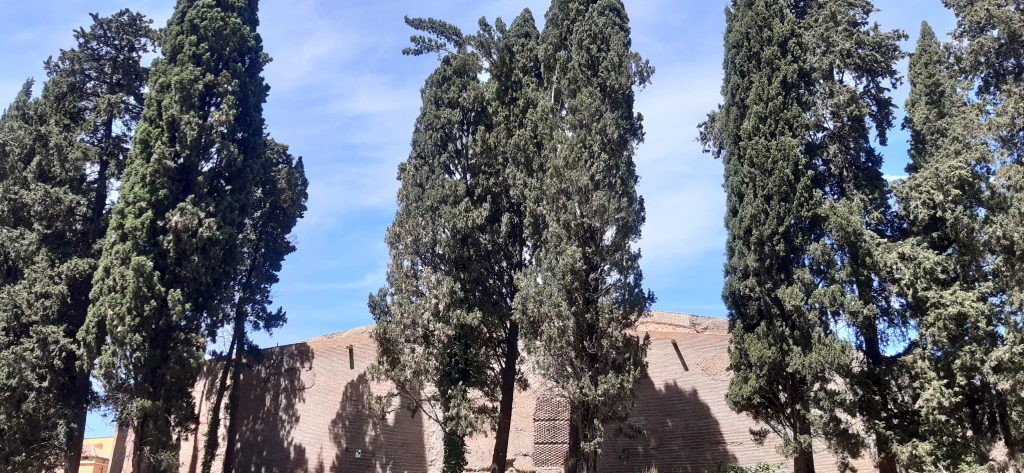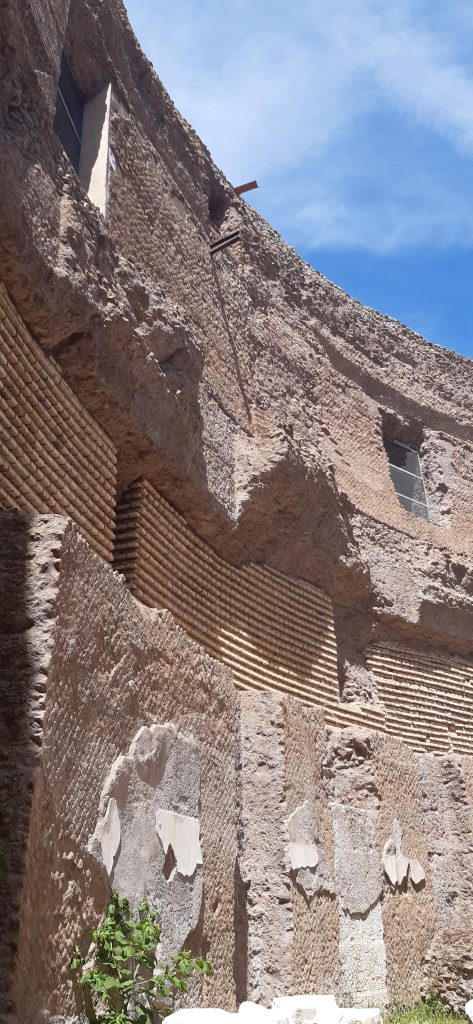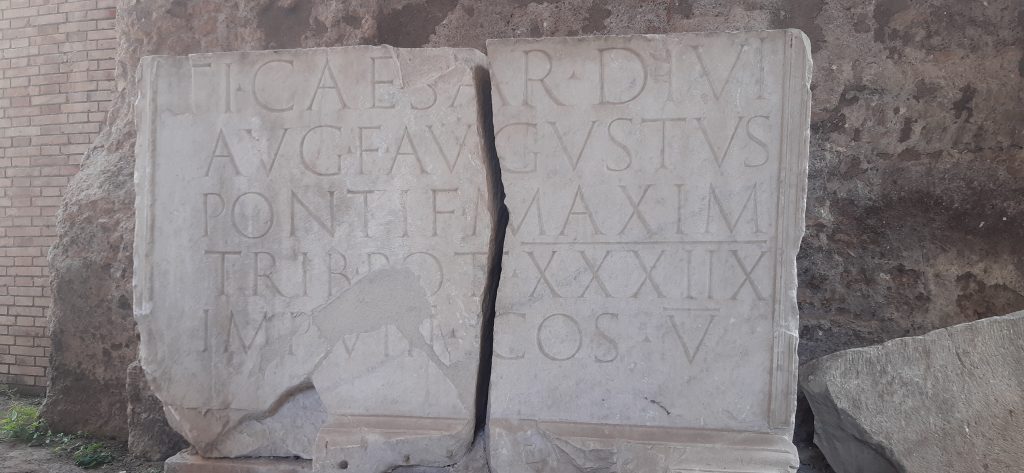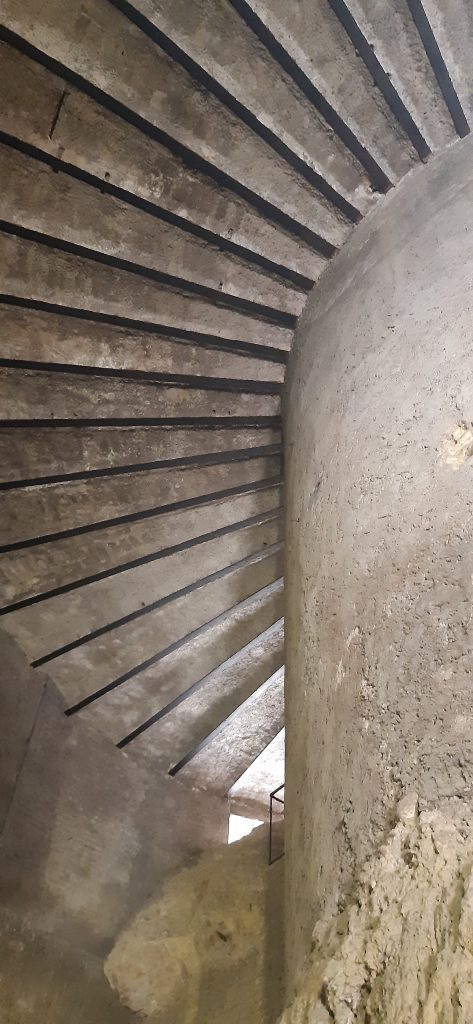Mausoleum of Augustus
Italian Version below*
It seemed like the usual endless restoration of the Eternal City, to which I am used to, but I have never lost hope of being able to enter this Monument which has been closed since 2007. A few days ago the dream came true and for the first time, my eyes crossed the grandeur of the Mausoleum of Augustus, restored thanks to the TIM Foundation.

In all these years of Roman life, I have also learned to appreciate these restorations “eternally in motion”. It must be said, for the record, that very often these ancient monuments really need a complex machine that can “cure them and bring them back to life”.
If the Mausoleum is therefore open to the public with accompanied visits, the outside of Piazza Augusto Imperatore is still an open-air construction site, but good final work is expected, thanks to the architect Francesco Cellini.
The Mausoleum of Augustus is the largest circular tomb in the world; inside were buried several exponents of the Gens Giulia, the Flavians, and also Giulia Domna, wife of the emperor Septimius Severus. With the fall of the Roman Empire in 476 AD, its slow and inexorable decline began.

It went through several stages until it became a theater in the 18th century, also known as the Korea Amphitheater, and used for jousting with the Bulls.
The idea of a mausoleum worthy of the first Roman emperor had flashed in the head of what was still Octavian, shortly after the Battle of Actium in 31 BC.

It was thus that in 28 BC work began, in the area of Campo Marzio dedicated to God Mars, to military exercises and camps, the fulcrum of the new monumentalization that Octavian wanted to leave in the city. In this same area will rise the Pantheon, the Ara Pacis, the Solar Clock or Augusteo gnomon.
The building is huge and majestic, it is hard to believe that it can have a diameter of almost 90 meters and a height of 45m, higher than the nearby Pincio hill!

In ancient times it was covered with marble and travertine, with evergreen cypresses on the outside and in the center a statue of the emperor for some attributable to the model of the Augustus of Prima Porta (now in the Vatican Museums).
Augusto dies in Nola, in the family home where he had taken refuge due to an illness. It was the 19th day of the sixth month of the Roman calendar which from that moment will be called August, the previous month is given the month of July (Julius Caesar), so that both could be remembered in all Western calendars.
He was about 77 years old. Through Suetonius we know his last words: “if you liked the show, applaud”.
After 14 days of travel, in a torrid Roman summer, which allowed the funeral procession to travel exclusively at night, to preserve the body, the emperor arrived in the place now known as Frattocchie but once, as Bovis Villae, the place of origin of the Gens Giulia.
The solemn ceremonies began in Rome on 4 September 14 AD. The testament was kept at the temple of the Vestals in the Roman Forum Tiberio’s ,adoptive son was named his successor.
In addition to the will, Augustus had left in custody to the Vestals, the Res Gestae. A priceless document that contained his “deeds”, that is an accounting and a list of what was done for the Roman people.
A modern copy of the Res Gestae is transcribed along one side of the Ara Pacis.
All rights reserved*
InfoSite: Mausoleum of Augustus
Follow me on FB/IG: selenia_eyeonart
Sembrava il solito restauro infinito della città eterna, a cui sono abituata, ma non ho mai perso le speranze di poter entrare in questo Monumento chiuso dal 2007.
Qualche giorno fa il sogno si è avverato e per la prima volta i miei occhi hanno incrociato la grandezza del Mausoleo di Augusto, restaurato grazie alla Fondazione TIM.

In tutti questi anni, di vita romana, ho imparato anche ad apprezzare questi restauri “eternamente in movimento”.
Va detto, ad onor di cronaca, che spessissimo questi monumenti così antichi, hanno davvero bisogno di una macchina complessa che possa “curarli e riportarli in vita”.
Se il Mausoleo è quindi aperto al pubblico con visite accompagnate, l’esterno della Piazza Augusto Imperatore è ancora un cantiere a cielo aperto, ma si preannuncia un bel lavoro finale, grazie all’architetto Francesco Cellini.
Il Mausoleo di Augusto, è la più grande tomba circolare al mondo; al suo interno furono sepolti diversi esponenti della Gens Giulia, dei Flavi ed anche Giulia Domna, moglie dell’imperatore Settimio Severo. Caduto l’Impero Romano nel 476 d.C., iniziò il suo lento ed inesorabile declino.

Attraversò diverse fasi, fino a diventare un Teatro nel XVIII secolo, noto anche come Anfiteatro Corea ed utilizzato per le giostre con i Tori.
L’idea di un Mausoleo degno del primo imperatore dei romani, era balenata nella testa di quello che era ancora Ottaviano, poco dopo la Battaglia di Azio del 31 a.C.

Fu così che nel 28 a.C. iniziarono i lavori, nella zona del Campo Marzio dedicata al Dio Marte, agli esercizi ed agli accampamenti militari.
Il Campo Marzio era il fulcro della nuova monumentalizzazione che Ottaviano voleva lasciare nella città. In questa medesima area sorgeranno il Pantheon, l’Ara Pacis, l’Orologio Solare o gnomone Augusteo.
L’edificio è enorme e maestoso, si fa fatica a credere che possa avere un diametro che sfiora i 90 metri ed un’altezza di 45m, superiore alla vicina collina del Pincio!

In antichità era ricoperto di marmo e di travertino, con cipressi sempreverdi esternamente ed al centro una statua dell’imperatore per alcuni riconducibile al modello dell’Augusto di Prima Porta (oggi ai Musei Vaticani).
Augusto muore a Nola, nella casa di famiglia dove si era rifugiato per una malattia.
Era il giorno 19 del sesto mese del calendario romano che da quel momento si chiamerà Agosto, al mese precedente viene dato il nome di Luglio (Giulio Cesare), così che entrambi potessero essere ricordati in tutti calendari occidentali.
Aveva circa 77 anni. Tramite Svetonio conosciamo le sue ultime parole: “se lo spettacolo vi è piaciuto, applaudite”.
Dopo 14 giorni di viaggio, in una torrida estate romana che consentiva al corteo funebre di viaggiare esclusivamente di notte, per preservare il corpo, l’imperatore arrivò nella località oggi nota come Frattocchie, ma un tempo come Bovis Villae, luogo di origine della Gens Giulia.
Il 4 settembre del 14 d.C. iniziarono a Roma le solenne cerimonie. Il testamento era conservato presso il tempio delle Vestali nel Foro Romano Tiberio, figlio adottivo, era nominato suo successore.
Oltre al testamento, Augusto aveva lasciato in custodia alle Vestali, le Res Gestae.
Documento di inestimabile valore che conteneva le sue “gesta”, ovvero una contabilità ed un elenco di quanto fatto per il popolo romano.
Una copia moderna delle Res Gestae è trascritta, lungo un lato dell’Ara Pacis.
InfoSite: Mausoleo di Augusto
Segui le mie pagine FB/IG: selenia_eyeonart
Sostieni la #culturachevince, aiuta la condivisione.
Tutti i diritti sono riservati. E’ vietata qualsiasi utilizzazione, totale o parziale, dei contenuti inseriti nel presente portale, ivi inclusa la memorizzazione, riproduzione, rielaborazione, diffusione o distribuzione dei contenuti stessi mediante qualunque piattaforma tecnologica, supporto o rete telematica, senza previa autorizzazione scritta di Selenia Morgillo.